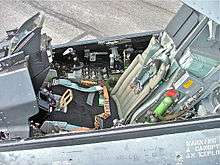Side-stick
A side-stick or sidestick controller is an aircraft control column (or joystick) that is located on the side console of the pilot, usually on the righthand side, or outboard on a two-seat flightdeck. Typically this is found in aircraft that are equipped with fly-by-wire control systems.[1]


The throttle controls are typically located to the left of a single pilot or centrally on a two-seat flightdeck. Only one hand is required to operate it; two hand operation is neither possible nor necessary.
The side-stick is used in many modern military fighter aircraft, such as the F-16 Fighting Falcon, Mitsubishi F-2, Dassault Rafale, and F-22 Raptor, and also on civil aircraft, such as the Sukhoi Superjet 100, Airbus A320 and all subsequent Airbus aircraft,[2] including the largest passenger jet in service, the Airbus A380.
It is also used in very new helicopter models like the 525 by Bell.
This arrangement contrasts with the more conventional design where the stick is located in the centre of the cockpit between the pilot's legs, called a "centre stick".
In the centre stick design, like traditional airplane yokes, both the pilot's and co-pilot's controls are mechanically connected together so each pilot has a sense of the control inputs of the other. In typical Airbus side-stick implementations, the sticks are independent, the so-called ‘passive’ side-stick. The plane's computer either aggregates multiple inputs or a pilot can press a "priority button" to lock out inputs from the other side-stick.[3] However, if both side-sticks are moved in different directions (regardless of which pilot has priority), then both inputs are cancelled out and an aural "dual input" warning sounds. Examples of this occurrence include the 2009 crash of Air France Flight 447 (an Airbus A330 flying from Rio de Janeiro to Paris), and the 2015 crash of Indonesia AirAsia Flight 8501 (an Airbus A320 flying from Surabaya to Singapore).[4][5]
However a later, significant, development is the 'active' side-stick,[6] which is in the new Gulfstream G500/G600 series business jet aircraft. In this system, movements in one side-stick produce the same actions in the other side-stick and therefore provides valuable feedback to the other pilot. This addresses the earlier criticisms of the 'passive' side-stick. The 'active' side-stick also provides tactile feedback[7] to the pilot during manual flight and many believe it will become the standard for all new ‘FBW’ aircraft.
Such an 'active' side-stick can also be used to increase pilots’ adherence to a safe flight envelope by applying a force feedback when the pilot makes a control input that would bring the aircraft closer to (or beyond) the borders of the safe flight envelope. This reduces the risk of pilots entering dangerous states of flights outside the operational borders while maintaining the pilots' final authority and increasing their situation awareness.[8]
See also
- Centre stick
- Yoke (aircraft)
- Fly-by-wire
References
- Crane, Dale: Dictionary of Aeronautical Terms, third edition, page 463. Aviation Supplies & Academics, 1997. ISBN 1-56027-287-2
- "Fly-by-wire - A CIVIL AVIATION FIRST". Airbus / Innovation / Proven concepts / In design / Fly-by-wire. Airbus. Archived from the original on 8 July 2012. Retrieved 6 July 2012.
- Getline, Meryl (2005-11-21), "Ask the captain", USA Today
- "Is Flight 447's 'Fly-by-Wire' Aircraft Technology Safe?". Fox News. 2009-06-12. Retrieved 2013-05-29.
- Ross, Nick (2012-04-28), "Air France Flight 447: 'Damn it, we're going to crash'", The Daily Telegraph (article),
It seems surprising that Airbus has conceived a system preventing one pilot from easily assessing the actions of the colleague beside him. And yet that is how their latest generations of aircraft are designed. The reason is that, for the vast majority of the time, side-sticks are superb.
- "Commercial Active Sticks - An Active Role". BAE Systems | International. Retrieved 2019-08-10.
- "BAE Brochure" (PDF).
- Florian J. J. Schmidt-Skipiol & Peter Hecker (2015). "Tactile Feedback and Situation Awareness-Improving Adherence to an Envelope in Sidestick-Controlled Fly-by-Wire Aircrafts.[sic]". 15th AIAA Aviation Technology, Integration, and Operations Conference: 2905. doi:10.2514/6.2015-2905.
External links
- Formation stick from Popular Science 1945.